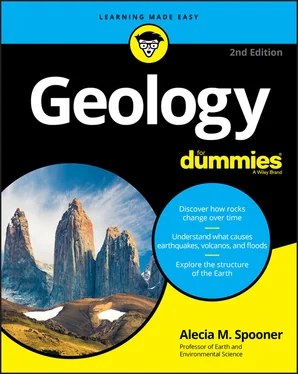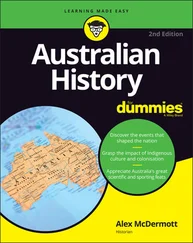There is no way to measure the temperature of the earth’s core. Scientists called geophysicists use laboratory studies of iron under conditions of extreme pressure to estimate how hot it may be at such depths. Their estimates range from 5,000 degrees F to 15,000 degrees F. More accurate measurements cannot be made because the conditions of temperature and pressure at the earth’s core are much too intense to be re-created in a laboratory setting.
Flowing and solid: The earth’s mantle
Outside the earth’s metal core is a layer of rock composing the mantle. Mantle materials are made of minerals that combine light elements (such as silica and oxygen) with heavier elements (such as iron and magnesium).
Similar to the core below it, the mantle has layers that respond differently to the movement of earthquake waves:
Mesosphere: In the lower mantle, surrounding the outer core, temperatures are high enough to melt rock, but the intense pressures found so deep in the earth keep mantle materials solid. This deep, solid part of the mantle is called the mesosphere. This layer of the mantle begins about 660 kilometers (410 miles) below Earth’s surface and continues to where it meets the outer core. Temperatures in the mesosphere range from 3,000 degrees F to almost 8,000 degrees F near the outer core.
Asthenosphere: The upper part of the mantle is called the asthenosphere and exhibits a special physical property. Mantle rocks are solid, but they flow in a way that you may associate with a thick liquid. When solid materials flow in this way, it’s called plastic flow. I describe plastic flow further in Chapter 13, where I discuss glaciers (which also move in this way). Some geologists describe the asthenosphere as a crystal mush , like a cold bowl of oatmeal — mostly solid, but still malleable.The asthenosphere is found starting at about 200 kilometers (124 miles) from the earth’s surface and extends down to the mesosphere. The heat and pressure in this layer can lead to some melting. Due to its ability to flow, this zone of the mantle is considered the weak zone; thus its name astheno, which means “weak” or “soft.”COLLECTING MOON ROCKSThe moon is not made of cheese after all. When NASA astronauts visited the moon during the Apollo missions of 1969 to 1972, they collected samples of moon rock material for scientists to test. It turns out the rocks of the moon have a composition similar to the earth’s mantle. The moon rocks — even those from deep within the moon — are similar to basalt (see Chapter 7) with almost no heavy metals. (The astronauts collected surface rocks and also drilled core samples.)This finding suggests that the moon did not form at the same time as the earth or from the same cloud of gas that formed the earth. (I discuss the earth’s formation in Chapter 18.) Rather, the composition of the moon rocks suggests that the moon was created by materials from the surface of the earth, long after the heavy metal core was covered by mantle and crust materials.While this idea is still being hotly debated, scientists have been testing the hypothesis that the materials that formed the moon were removed from the earth by a giant impact. Another planet-type body, possibly as large as Mars, may have crashed into Earth, vaporizing some of its crustal and upper mantle materials, leaving them to orbit the earth until they came together forming the sphere now known as the moon.Wouldn’t there be a giant crater as evidence of such an impact? At the time, yes, but this was 4.5 billion years ago, and since then much about the earth and its surface has dramatically changed. The best evidence scientists have is the composition of the moon rocks. Using isotope studies, geologists continue to test the giant-impact hypothesis of moon formation.
Lithosphere: The uppermost portion of the mantle is attached to the underside of the earth’s crust, and together they make up the lithosphere. This portion of the mantle is approximately 100 kilometers (62 miles) thick, very rigid, and brittle — it breaks and cracks rather than bends or flows. Physically, this part of the mantle is just like the rocks of the crust it is attached to (a brittle solid). But this layer is still mantle because of its mineral composition. In other words, when scientists classify the earth’s layers based on their composition, they separate the upper portion of the mantle from the crust because they are composed of different minerals. But when scientists classify the earth’s layers based on physical properties, both the uppermost part of the mantle and the earth’s crust are part of the brittle lithosphere and different from the flowing solid mantle below.
It’s only skin deep: The earth’s crust
The boundary between mantle rock and crustal rock in the lithosphere is labeled the Moho discontinuity, named after the scientist who discovered it, Andrija Mohorovičić. This boundary, illustrated in Figure 4-4, is where the composition of rocks changes from the more dense mantle rocks to the much lighter crustal rocks, which are composed primarily of silica.
 The layer of crust covering the earth comes in two types: continental and oceanic . These two types of crust vary in thickness and are composed of slightly different materials:
The layer of crust covering the earth comes in two types: continental and oceanic . These two types of crust vary in thickness and are composed of slightly different materials:
Continental crust: The crust that composes the continents is pretty thick. At its thinnest sections, continental crust is about 12 miles thick; at its thickest sections (where there are mountains), it is up to about 45 miles thick. The rocks that compose the continental crust are primarily granites (see Chapter 7).
Oceanic crust: This crust, which lies under the earth’s oceans, is thin — only about 5 miles thick. This type of crust is composed of dark, dense silicate rocks such as basalt and gabbro (see Chapter 7). Oceanic crust is relatively young, being created even now from the eruption of molten rock along ridges in the sea floor (see Chapter 10).
In 1909, Andrija Mohorovičić, a Croatian seismologist, noticed that earthquake waves increased their speed as they moved through the lower part of the earth’s rigid lithosphere. He interpreted (correctly) that this meant the lower portion of Earth’s lithosphere is made of a different and slightly denser material than the outer portion. The line where the material in Earth’s lithosphere changes from the crustal rock to the mantle rock is named the Moho line or the Mohorovičić Discontinuity.
For decades scientists have attempted drilling deep into the earth, seeking to reach the Moho line between the mantle rock and crustal rock within the lithosphere. In 2005, a team of scientists with the Integrated Ocean Drilling Program (IODP) came close. The core they drilled near the mid-Atlantic ridge in the Atlantic Ocean reached a depth of 1,416 meters (4,644 feet) into the oceanic crust. But the rocks they recovered appear to be made of crustal rock materials rather than the mantle rocks they were seeking. The researchers concluded that they were close to crossing the Moho discontinuity boundary and plan to attempt drilling a new hole.
Every inch closer to the Moho provides scientists with new information about the composition and formation of the earth’s outermost layer and offers clues to the internal structure of Earth’s lithosphere.
Part 2
Elements, Minerals, and Rocks
IN THIS PART …
Discover the chemistry of elements and compounds.
Learn the basics of minerals.
Читать дальше

 The layer of crust covering the earth comes in two types: continental and oceanic . These two types of crust vary in thickness and are composed of slightly different materials:
The layer of crust covering the earth comes in two types: continental and oceanic . These two types of crust vary in thickness and are composed of slightly different materials:










